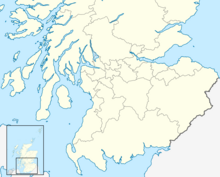| Battle of Pinkie | |||||||
|---|---|---|---|---|---|---|---|
| Part of the Rough Wooing | |||||||
 River Esk and Inveresk Church at Musselburgh | |||||||
| |||||||
| Belligerents | |||||||
|
|
| ||||||
| Commanders and leaders | |||||||
| Earl of Arran | Duke of Somerset | ||||||
| Strength | |||||||
| 22,000-36,000[1] |
c. 30 warships 16,800 men[2] | ||||||
| Casualties and losses | |||||||
|
6,000–15,000 killed or wounded[3] 2,000 captured[3] | 200–600 killed or wounded[4] | ||||||
| Designated | 21 March 2011 | ||||||
| Reference no. | BTL15 | ||||||
Battle location in Scotland | |||||||
The Battle of Pinkie, also known as the Battle of Pinkie Cleugh (English: /klʌf/ KLUF, Scots: [kl(j)ux]),[5] took place on 10 September 1547 on the banks of the River Esk near Musselburgh, Scotland. The last pitched battle between Scotland and England before the Union of the Crowns, it was part of the conflict known as the Rough Wooing. It was a catastrophic defeat for Scotland, where it became known as "Black Saturday".[6] A highly detailed and illustrated English account of the battle and campaign authored by an eyewitness William Patten was published in London as propaganda four months after the battle.[7]
- ^ MacDougall, p. 73
- ^ MacDougall, p. 68
- ^ a b MacDougall, p. 86
- ^ MacDougall, p. 87
- ^ Mairi Robinson, The Concise Scots Dictionary (Edinburgh University Press, 1999), p. 101.
- ^ Phillips, p. 193
- ^ Marcus Merriman, The Rough Wooings: Mary Queen of Scots, 1542–1551 (Tuckwell: East Linton, 2000), pp. 7–8.
